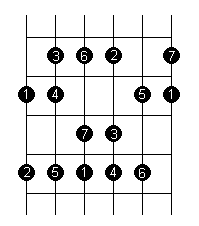Yet More Exercises
This is another tutorial which was inspired by questions from the AllExperts
website - if you haven't visited AllExperts yet then you really
ought to.
Following on from a previous
tutorial, this tutorial introduces a basic idea for an
exercise which covers a basic idea for an exercise, which once
you've got to grips with it, it should be easy enough for you to
as a starting point and adapt it into variations of your own.
The Basic Exercise
| The basic exercies here is based the major scale 'box', and
follows a pattern of diatonic thirds moving upwards
through the scale. The pattern here is to play a note
from the scale, followed by the next-but-one note up from
that, followed by the note that falls in between these
two notes. This might sound a bit complicated, but one
you start playing the pattern (1-3, 2-4, 3-5, etc) you'll
see that it's a lot more logical than it sounds.
|
  |
Here's the basic exercise written out in notation, in the key
of C major.


As with all exercises, remember that out-and-out speed is not
the primary objective. Start at a pace whereby you can play
accurately and smoothly, then build up speed as you become more
proficient.
This exercise could be used purely as a means of honing your
playing technique, but you may also find it helpful as an
exercise in learning the notes in a scale. As you play each note
say (or think) both the note name and its number from within the
scale (e.g. "C 1 - E 3, D 2 - F 4, E 3 - G 5...").
Obviously, this limit how quickly you can actually play the
exercise, but in this case, speed is not the ultimate goal.
Variations
There are obviously several different ways that you can adapt
this basic exercise. I'll give you a few suggestions here, and
you can take these ideas and either use them verbatim, or develop
your own variations
Descending
The most obvious variation, really. Instead of moving upwards
through the scale, start on the highest notes, and move down in
patterns of 1-6, 7-5, 6-4 and so on.
Other Positions
Don't just run through this exercise in the key of C major -
move the scale 'box' around the neck and play in different keys.
I'd suggest that you follow the Circle of Fifths from C,
moving clockwise, rather than simply moving up or down a semitone
after each repetition. This is especially useful if you're using
this as an exercise for learning note names in each key.
Other Scale Types
Instead of just using the major scale, use other scales such
as the natural minor, harmonic minor and modes (this exercise
doesn't work quite so well with pentatonics, though). If you're
using this exercise to learn note names, when you say a notes
number, remember to use the numbering that is applicable to the
scale formula (e.g. "b3" instead of "3" in a
minor key, and so on).
Rate This Tutorial
How useful did you find this tutorial?

